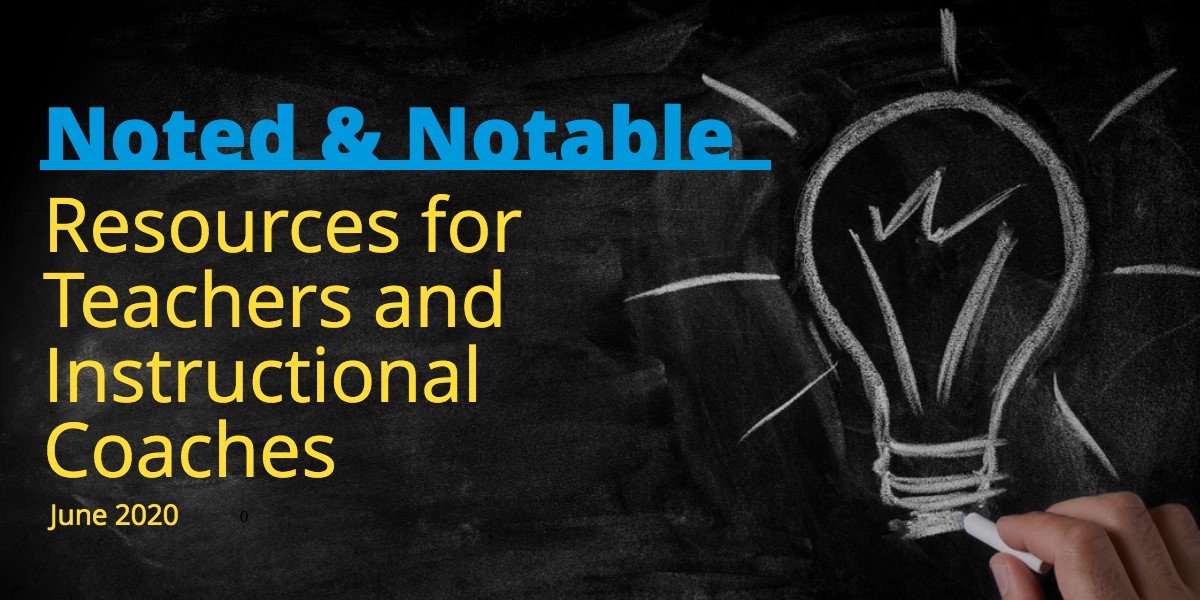Resources for Teachers & Instructional Coaches – June 2020

Regardless of the format for learning, whether it be a distance teaching or live classroom environment, teachers are still the lifeblood of a school’s success. They are the frontline workers for our students. Here are some resources for educators that are centered around planning for professional development in the next academic year, as well as some classroom management tips for distance teaching.
Provide educators a choice for their professional development. Administrators are thinking now about the best ways to support their teachers
There is still plenty of uncertainty about what school will look like this fall. Consequently, educators need to be given various options for professional learning. This could be in the form of a book study with a colleague, a free webinar, a virtual workshop, or an online tool focused on professional development.
As the school year winds down, school leaders (and parents) are beginning to speculate about what classrooms will look like in the fall of 2020. I suspect that, with the safety of students in mind, we will still have strong social distancing guidelines in place in many states, and in some cases schools may have a mix of at-home and in-person instruction. But what does this mean for the classroom and for pedagogy? Teachers will need to flex their trial-and-error muscles while translating highly effective brick-and-mortar learning experiences to the online world. They will also need training and support in using videoconference systems in and out of the classroom, and in figuring out how to attend to the needs of students sitting at desks in the school building (and in their home living rooms). And we need to address the technology gap and other inequities that distance learning is shining a spotlight on.
Of course, we also think that providing direct feedback on distanced teaching is also an important ingredient in your Covid-ready PD plan.
Read more on Edutopia: Planning for Better Professional Development in an Uncertain Future
Classroom management is a vital part of teaching, even when the instruction is happening online
As teachers engage in remote learning, videoconferencing features can limit distractions and redirect student misbehavior. Here are some details about those features and a few online classroom management strategies teachers can utilize.
Teachers can use a digital reward system to encourage good behavior with younger students. For example, when students raise their hands and properly unmute themselves, the teacher can award them points. Students can exchange the points they earn for digital rewards such as a virtual lunch with the principal or getting to choose things such as the next story to be read. With older students, review expectations before each lesson. It’s also important to be well organized and as engaging as possible to deter boredom-induced misbehavior.
Regardless of the videoconferencing program used, it is important to establish norms at the start of every session to hold students accountable. Adhere to the same standards of behavior while videoconferencing that are required in the classroom.
Read more on EdTech Magazine: How to Encourage Good Student Behavior While Videoconferencing
When designing a remote learning schedule, start times can boost well-being and engagement
Glenn Whitman and Ian Kelleher, the authors of “Neuroteach: Brain Science and the Future of Education, are educators at St. Andrew’s Episcopal School in Potomac, Maryland. They detail how their school launched a daily schedule based on brain science. It was designed to encourage deeper learning and student wellbeing. Although their school closed during, COVID-19, they turned to research to revise their schedule again.
We know that one thing will never change. The brain, whether learning on campus, fully online or in a blended environment, is the organ of learning. So the same research from the field of Mind, Brain and Education that we used in 2018 to create our new at-school schedule became the starting point for designing what distance learning should look like as well. Because we understand the underlying principles that help students learn, we were able to reimagine school online, rather than just trying to recreate the same bricks and mortar experience. What must online school include? And how do we do it?
Read more on EdSurge: How Brain Research Helped Retool Our School Schedule for Remote Learning

